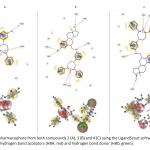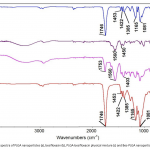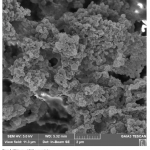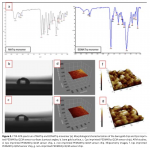| Title | Pages |
|---|---|
| Synthesis of Two 7, 8-Dioxabicyclo[4.1.1]Octan-3-Yl)- Steroid Derivatives and Evaluation of Their Inotropic Activity in an Animal Model The aim of this study was synthesizing two 7,8-dioxabicyclo[4.1.1]octan-3-yl)-steroid derivatives (compounds 3 or 4) to evaluate their inotropic activity in vitro. The first stage was achieved by the preparation of two 7,8-dioxabicyclo[4.1.1]octan-3-yl)-steroid derivatives using some chemical strategies. Then, the inotropic activity of both steroid derivatives against left ventricular pressure (LVP) was evaluated in an isolated rat heart model using Bay-k-8644, nifedipine, aucubin and L-NAME as controls. The results showed that compound 3 increased LVP in a dose-dependent manner and this effect was inhibited by nifedipine. Other results showed that compound 4 decreased LVP in a dose-dependent manner and this effect was blocked in presence of L-NAME. All these data indicate that 1) the positive inotropic activity exerted by compound 3 was through type L calcium channel activation; 2) the negative inotropic effect of 4 was via nitric oxide synthase activation; these phenomena could be due to the different functional groups involved in the chemical structure of compounds 3 and 4. Therefore, the inotropic activity that exerts these compounds could be translated as good candidates for the treatment of heart failure. 



|
1 - 12 |
| Effects of Exercise Performed at High Altitude on the Chromosomal DNA Damage in Human Peripheral Lymphocytes High altitude hypoxia and hypoxic exercise may induce oxidative DNA damage.Our study was investigated the effect on the micronucleus (MN) frequency of performed exercise at 1055m and at 2500m. MN frequency is a biomarker of chromosomal damage, genome instability. 10 female and 10 male totally 20 subject were included in the study. They performed exercise 3 hours per day during 5 days at each two location. The peripheral blood samples obtained before exercise and immediately after the exercise at 1055 m and 2500 m altitude both first day and fifth day were cultured. The number of MN values was scored in binucleated cells obtained from mitogen-stimulated lymphocytes of subjects. We found that exercise performed at 1055m conditions induced MN formation (p<0.001); whereas exercise performed at 2500m induced more MN formation in human lymphocytes (p<0.001). In addition , in the subjects after ten days came back down to 1055 m from the mountain MN frequencies was decreased that those of at the end of the five day at 2500 m altitude (p<0.001). Also, this MN frequency was similar to with basal MN frequency at 1055 m (p>0.05).Our results indicated that exercise and altitude may cause chromosomal DNA damage and may be closely relative to mutagenic effects. 



|
13 - 20 |
| A HILIC Stationary Phase Functionalized with Glutathione by Thiol-Ene Chemistry on Monodisperse-Porous Polymer Microparticles Monodisperse-porous microparticles functionalized with glutathione by thiol-ene chemistry were synthesized as a new stationary phase for hydrophilic interaction chromatography. Monodisperse-porous poly(3-trimethoxysilylpropyl methacrylate-co-ethylene dimethacrylate), poly(TMSPM-co-EDMA) microspheres (6 μm in size) were obtained with different seed latex/monomer ratios and diluent compositions by multistage microsuspension copolymerization. The zwitterionic chromatographic ligand containing thiol moiety (i.e. glutathione) were covalently attached onto the TMSPM attached-poly(TMSPM-co-EDMA) microparticles. The selected starting material allowed the direct attachment of zwitterionic ligand onto the support material using thiolene chemistry. The derivatized microparticles were slurry packed into the microbore columns with 2 mm i.d. and used as stationary phase for the separation of nucleosides in hydrophilic interaction chromatography with the plate numbers up to 54.000 plates/m. The results showed the usability of tailored poly (TMSPM-co-EDMA) microparticles as a stationary phase and thiolene chemistry in the manufacture of a chromatographic stationary phase with high efficiency in hydrophilic liquid chromatography applications. 



|
21 - 31 |
| Synthesis, Characterization and Antimicrobial Studies of New Chiral Amide-Schiff Base Derivatives In this study, new chiral Schiff bases (3-9) were synthesized via the reaction of chiral amide derivatives with various substituted aromatic aldehydes. The structures of the newly synthesized compounds were characterized by FTIR, 1H-NMR, 13C-NMR and elemental analysis. All of these Schiff bases were tested in vitro against Staphylococcus aureus, Bacillus cereus, Escherichia coli, Salmonella thyphimirium, Klebsiella pneumoniae, Enterococcus faecalis, Pseudomonas aeruginosa, Candida albicans for their antibacterial and antifungal activities. All compounds have shown moderate to good antibacterial activity against Gram-positive and Gram-negative bacteria. Among the tested compounds compound 7 was found to show the most potent inhibitory action against test organisms. 



|
33 - 39 |
| Comparison of Bacterial DNA Extraction Methods From Stool Samples for Quantitative Real-Time PCR Analysis The most crucial step in molecular microbiology studies is choosing an appropriate procedure to obtain sufficient, high-quality DNA. Two commercially available kits (QIAamp DNA Stool Mini Kit, Qiagen and PSP Spin Stool DNA Plus Kit, Invitek) and a modified in-house phenol-chloroform extraction method was compared for their efficiency in isolation of certain bacteria from human stool samples for Real-Time qPCR. DNA yield was significantly higher in Invitek when compared to other methods. Spiking experiments and qPCR results revealed that efficiency was in phenol-chloroform extraction was lower when compared to other two commercial kits. Commercial kits have better results in terms of DNA recovery and purity, and have more accurate results for qPCR experiments. 


|
41 - 48 |
| Preparation and Characterization of Nanoparticular Systems for Topical Treatment of Ocular Infections In this study, the active ingredient of besifloxacin was loaded into PLGA nanoparticles and the usability of the obtained nanoparticles as a controlled drug release system for the treatment of bacterial conjunctivitis was investigated. Besifloxacin was selected because it does not contain a systemic formulation and is effective against both gram-positive and gram-negative pathogens. After topical application, besifloxacin was loaded into PLGA nanoparticles and tested for effectiveness in order to prolong the residence time of besifoxacin. For this purpose, besifloxacin loaded PLGA nanoparticles were characterized and toxicity and in vitro release studies were performed. Nanoparticles were characterized as morphological structure by scanning electron microscopy (SEM), size and charge analysis by Zeta Sizer and physicochemical structure by Fourier Transform Infrared Spectrometry (FTIR). According to the Zeta Sizer results, the nanoparticles have a mean size of 200nm and the SEM images support the results. It was determined that 40% of the initial concentration of besifloxacin active substance was loaded on PLGA nanoparticles as a result of the determination of the amount of drug found in the supernatant. The release pattern of besifloxacin from the nanoparticles was not found to be burst effect but was released in a slower and more controlled manner. 



|
49 - 58 |
| New Floristic Records for A4 and A5 Squares from Tosya District (Kastamonu) In this study, 47 taxa are given as new records from Tosya district in Kastamonu province. The research area is situated in A4 and A5 squares according to the Davis' grid system. 23 Angiospermae taxa for A4 square and 24 Angiospermae taxa for A5 square, totally 47 taxa belonging to 23 families have been determined as new records. One of them is rare and 9 taxa are endemic.
|
59 - 64 |
| The Effect of Aqueous Extract of Pine Kindling on the Liver and Kidney Tissues of Diabetic Rats In this study, the effect of aqueous extract of kindling wood obtained from pine trees on liver and kidney tissues of streptozotocin (STZ)-induced diabetic rats was investigated. Male Sprague Dawley rats were divided into five groups: 1) Control, 2) STZ rats 3) STZ rats treated with aqueous extract obtained from kindling wood of pine trees (respectively 100 g/L, 200 g/L and 400 g/L) for 10 weeks. According to our results, it was determined that this extract showed beneficial effects on oxidative stress (Malondialdehyde (MDA), Reduced glutathione (GSH), Oxidized glutathione (GSSG)) in liver and kidney tissues. Pine kindling extract showed generally positive effects on glycogen, cholesterol, alpha tocopherol, retinol, palmitic acid, stearic acid, oleic acid, linoleic acid, arachidonic acid and docosahexaenoic acid parameters in the liver and kidney tissues of diabetic rats. Pine kindling extract did not showed inhibitory effect on the amylase enzyme activity derived from bovine, porcine pancreas, fungi and bacteria during in vitro experiments. Pine kindling extract also did not exhibit inhibitor effect on α-glycosidase enzyme that hydrolyzes disaccharides. 



|
65 - 74 |
| Detection of Pesticide via Nanoparticle Based Quartz Crystal Microbalance Sensor In this study, chlorpyrifos (Cps) imprinted nanoparticles based QCM sensor were prepared for the detection of chlorpyrifos pesticide. Cps imprinted poly(ethylene glycol dimethacrylate- N- metacryloyl- (L)- tryptophan) (PEDMATrp) nanoparticles were prepared and then these nanoparticles were attached to the surface of QCM sensor chip. Also, non-imprinted PEDMATrp QCM sensor was prepared without using Cps molecule to evaluate the imprinting efficiency. Cps imprinted and non-imprinted nanoparticles were characterized by zeta-sizer and Fourier transform infrared spectrophotometer-attenuated total reflection (FTIR-ATR) spectrophotometer. Cps imprinted and non-imprinted QCM sensors were also characterized by atomic force microscopy, ellipsometer, and contact angle measurements. The prepared sensors were applied for selective Cps detection in aqueous solution for the range of 0.015-2.9 nM. The selectivity studies of the QCM sensor were examined by using competitive pesticide molecules such as diazinon and parathion (2.9 nM), which are similar to Cps in size and shape. The reusability studies of the prepared sensors were investigated by applying the same pesticide concentration (1.45 nM), four times consecutively. 



|
75 - 82 |
| Three-Phase Partitioning OF α-Galactosidase From Aspergillus Lentulus: Optimization of System And Characterization of Enzyme Three-phase partitioning (TPP) technique is successfully used for the first time for partial purification of α-galactosidase from Aspergillus lentulus in single step. The influence of variations in ammonium sulfate concentration, extract to t-butanol ratio and pH on extraction efficiency of the enzyme are investigated to achieve the highest yield and purity fold. Optimal purification parameters of the system are determined as 55% (w/v) ammonium sulfate concentration with 1:1 (v/v) ratio of crude extract to t-butanol at pH 5.5. This optimized TPP system gave 5.3 purification fold with 178% recovery of α-galactosidase. The maximum activity was registered at pH 6.5 and 50°C. α-Galactosidase showed a good stability within the temperature range of 25-60°C and pH range of 2.6-5.5. The KM and Vmax values were determined as 0.365 mM and 0.093 U, respectively. Among the metals and sugars Na2CO3 and galactose showed strong inhibitory effect on the activity of enzyme. The availability of a new α-galactosidase with different biochemical properties from A. lentulus by using TPP may be of interest for its various biotechnological applications. 



|
83 - 98 |